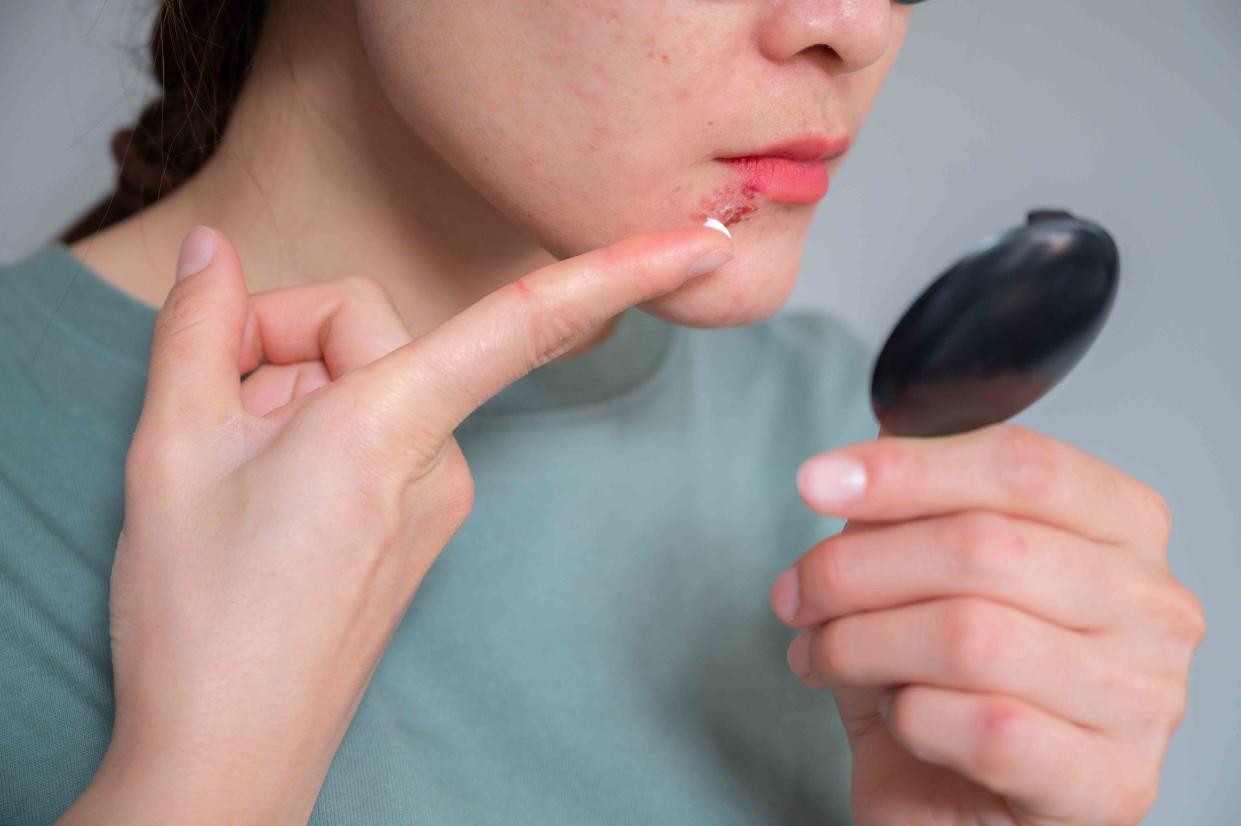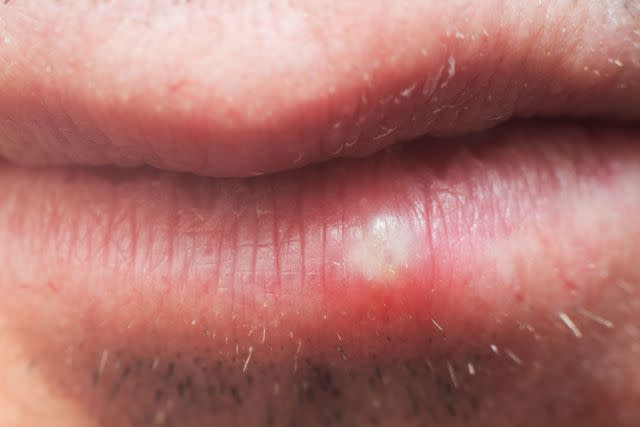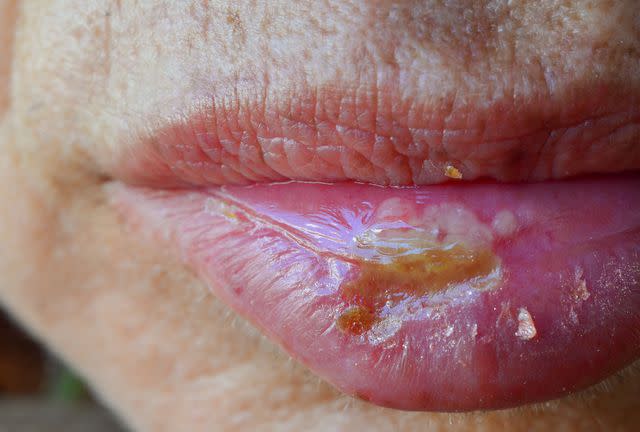Signs and Symptoms of Cold Sores

Boy_Anupong / Getty Images
Medically reviewed by Susan Bard, MD
Cold sores, or fever blisters, are small fluid-filled blisters that develop on or around the lips, often in clusters. They can also develop on your chin, cheeks, or nose. Cold sores are caused by the herpes simplex virus (HSV)—a highly contagious virus that spreads through close contact or sharing items (e.g., utensils, lip balm) with someone who is having an active flare-up of HSV.
An estimated 67% of the world’s population carries the HSV virus, which is known as being a "carrier." Once you are a carrier, the virus lies dormant in your body’s nerve cells and can reactivate in response to certain triggers (e.g., stress, illness).
Not everyone with HSV will develop cold sores, but in those who do, symptoms can vary from person to person. Some people may experience infrequent or mild outbreaks, while others may have more frequent and severe flare-ups.
Common Symptoms
Cold sores symptoms typically follow a distinct five-stage pattern:
Tingling (prodrome)
Blistering
Oozing
Crusting
Healing
Most cold sores heal within 7 to 15 days, though initial outbreaks may last longer. You may experience flu-like symptoms just before your first cold sore develops, such as:
Body aches
Headache
Fever
Swollen lymph nodes
Once you have an initial cold sore outbreak, you may experience recurrences (repeat outbreaks). Symptoms during recurrent outbreaks are often less severe than the initial episode and occur less frequently.
Stage 1: Tingling
The initial stage of a cold sore is known as the tingling or prodrome stage. During this stage, you may feel a tingling, itching, or burning sensation in the area where a cold sore is about to develop. It may feel tender or sore when you touch the area. The tingling sensation can last a few hours or up to a day before progressing to the next stage of cold sore development.
Stage 2: Blistering
The blistering stage is when small, fluid-filled blisters begin to form in the area that may have previously felt tender or itchy. The blisters can be painful and may develop in a cluster. The surrounding skin may be red and swollen. Over a short period, the blisters may increase in size and number, eventually reaching their peak before progressing to the next stage in two to three days.
Cold sores are highly contagious at this stage and can spread to other people, so avoiding intimate contact (e.g., kissing) or sharing personal items is especially important. If you touch your cold sore, wash your hands immediately to prevent spreading the virus to other body parts.

Andrei310 / Getty Images
Stage 3: Oozing
The blisters burst open at this stage, leaking a clear or yellowish fluid. This leaves a shallow, open sore (ulcer) surrounded by a red, inflamed ring. For many, this is the most painful stage of a cold sore, lasting about two to three days. Cold sores are still highly contagious, and it is important not to touch your cold sore to prevent a secondary (bacterial) infection and reduce the risk of spreading the virus.

fotoco-istock / Getty Images
Stage 4: Crusting
The open sore begins to dry out at this stage, forming a yellowish crust that eventually turns into a brown scab. The scab acts as a protective layer over the healing skin underneath. Your scab may crack and bleed as it shrinks and feel sore, painful, or intensely itchy for a few days. Do not attempt to pick or scratch the scab, as this can delay healing and increase the risk of infection.

sruilk / Getty Images
Stage 5: Healing
The scab gradually dries up and falls off during the healing stage, revealing healed skin beneath. The new skin may appear pink or red for a few days, and the surrounding area may be dry and flaky. The duration of this stage varies, but it generally takes about two days before the affected area appears normal. Most cold sores heal without leaving scars.
When to See a Healthcare Provider
While cold sores typically resolve within 7 to 15 days, certain symptoms and situations may require medical attention. See a healthcare provider if:
You have a weakened immune system
The cold sores do not heal within two weeks
You have frequent outbreaks (more than three times per year)
You should also see a healthcare provider if you experience any of the following symptoms:
Sores near the eyes
Gritty or runny eyes
Eyes sensitive to light
High fever
Pus oozing from or near the cold sore
Spreading redness that extends beyond the sore
Related: How To Treat a Cold Sore
A Quick Review
Cold sores are painful fluid-filled blisters commonly appearing on or around the lips. Cold sores are a symptom of the herpes simplex virus (HSV)—a highly contagious virus that remains dormant in the body for life and can reactivate due to certain triggers, such as stress, illness, and fatigue.
Cold sore symptoms develop in stages: tingling/prodrome, blistering, oozing, crusting, and healing. Most cold sores heal within 7 to 15 days. See a healthcare provider if you have a severe outbreak, sores near your eyes, or flu-like symptoms such as fever and body aches. You should also see your healthcare provider if you have frequent cold sore outbreaks or sores that do not heal within two weeks.
Cold sores are highly contagious throughout the entire cycle, and avoiding intimate contact (e.g., kissing) and touching the sore is important to prevent spreading the virus to other people and other body parts.
Frequently Asked Questions
How long are cold sores contagious?
Cold sores are contagious from when the tingling or itching sensation begins until the scab has completely healed. This typically takes between 7 to 15 days.
Can you kiss someone with a cold sore?
Kissing someone with an active cold sore is not recommended, as the virus is highly contagious and spreads through direct contact with cold sores. It is best to avoid intimate contact until the cold sore has fully healed.
What is the cycle of a cold sore?
Cold sores typically progress through five stages: tingling (prodrome), blistering, weeping, crusting, and healing. Each stage has a distinct set of symptoms and duration, with the entire cycle lasting approximately 7 to 15 days.
What causes cold sores to flare up?
Common cold sore triggers include stress, fatigue, illness, hormonal changes, sun exposure, and a weakened immune system. Identifying and avoiding these triggers can help reduce the likelihood of cold sore outbreaks.
For more Health news, make sure to sign up for our newsletter!
Read the original article on Health.

